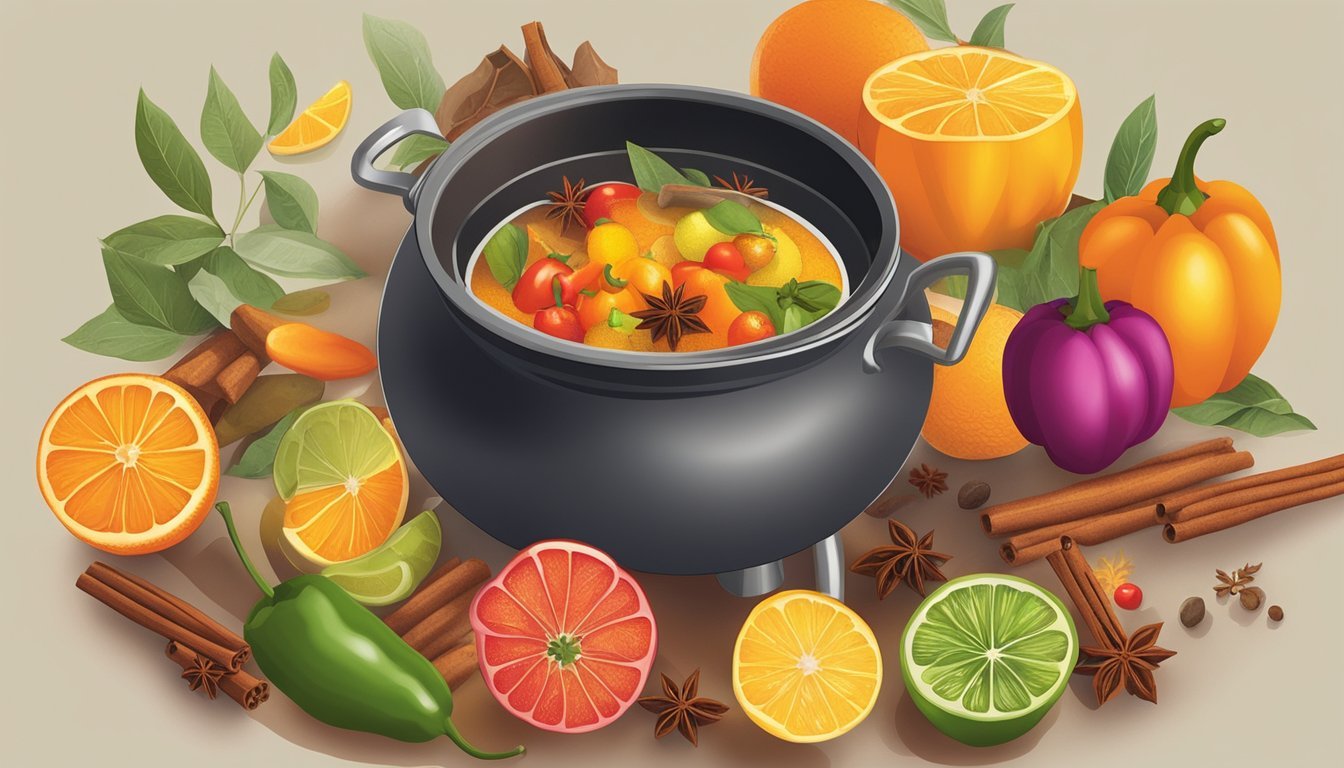The Origins of Swicy
Exploring the Rise of Sweet-Spicy Flavor Profiles
Swicy, a portmanteau of sweet and spicy, represents a flourishing flavor trend captivating the palates of food enthusiasts. This taste sensation leverages the harmonious counterbalance of sugary delights with the sharp kick of spicy elements. The trend, while it seems novel, draws on a long-standing human fascination with combining contrasting flavors to enrich the culinary experience.
In recent years, the appeal of swicy flavors has spiked, with its presence on restaurant menus jumping significantly. Market analysis indicates that concoctions like hot honey are at the forefront of this movement, suggesting a broader shift in consumer preferences toward more complex and layered taste profiles. This surge in swicy dishes is not just a reflection of changing tastes but also an echo of traditional flavor pairings that have been cherished for generations.
The ascent of swicy offerings can also be attributed to a particular resonance with younger consumers, particularly Gen Z and Millennials, who often champion bold and innovative food choices. This demographic's embrace of the swicy combination dovetails with a broader trend of exploring and popularizing food experiences on social media platforms, where the visual appeal of dishes is almost as important as their taste.
The Evolution of Swicy
In recent years, the fusion of sweet and spicy flavors, known as "swicy," has surged in popularity. This section explores the historical underpinnings, global influences, and pop culture ascendancy that have propelled swicy to the forefront of culinary trends.
Historical Perspective
Throughout history, the interplay between sweet and spicy flavors has tantalized palates. Initially found in traditional cuisines, these combinations have been present for centuries, as cooks sought to balance and enhance flavors. Market research institutions like Datassential have recently quantified swicy's prevalence, noting significant menu upticks that suggest a modern renaissance of this flavor pairing.
Influence of Global Cuisines
Globalization has facilitated a rich crossover of culinary traditions, contributing significantly to the swicy movement. Key global cuisines have long celebrated the complexity that emerges when sweet meets spicy, from the fiery, honey-laced dishes of Asia to the fruit-infused chili sauces of Latin America. The melding of flavors from various cultures has played a pivotal role in the evolution of swicy, expanding its appeal across diverse palates.
Notable Global Contributions:
Asia: Integration of chili with sweet elements like mango and tamarind.
Latin America: Use of spicy peppers complemented with sweet fruits in salsas and sauces.
Rise of the Swicy Trend in Pop Culture
Social media platforms like TikTok have amplified the swicy trend, particularly among younger demographics like Gen Z and Millennials. These groups have showcased their swicy infatuations through viral videos highlighting the balance achieved when combining sweet and spicy flavors. As a result, what once was a staple of niche recipes has become a sought-after staple in mainstream food culture.
Evidence of the Popularity Surge:
TikTok: Shared recipes and food challenges that celebrate the swicy trend.
Restaurants: Menus increasingly featuring swicy options to cater to evolving consumer tastes.
By adapting traditional flavor pairings into contemporary cuisines and embracing the cultural zeitgeist, swicy has evolved from a simple taste combination into a dynamic, marketable trend.
Swicy in the Market
The swicy flavor trend is riding a wave of popularity, anchoring itself in the market as consumer demand escalates and innovation flourishes across the food industry.
Consumer Demand and Market Growth
Market research provides quantitative backing to the swicy trend's escalation. A market research firm called Datassential reported a 38% rise in sweet and spicy pairings on menus over the last year. It demonstrates a notable surge in consumer interest, with hot honey anticipated to overtake many other flavors in terms of growth.
Innovations in Swicy Products
The product landscape has evolved with new swicy-infused offerings. Innovations include the introduction of chocolate bars with chili, an early swicy product, and the broader use of hot honey, which now finds its way into an array of food items from fried chicken to desserts. Food producers are integrating swicy flavors into sauces, pastries, and drinks to meet the growing demand.
Impact of Swicy on Foodservice Industry
The foodservice industry is recognizing the swicy trend's potential, as noted by entities like the National Restaurant Association. Restaurants are readily incorporating swicy dishes into their menus, partly in response to Gen Z and Millennial preferences. Market research agencies observe that these sweet-spicy offerings are not just passing fads but are becoming staples that distinguish contemporary restaurant menus.
Key Ingredients and Pairings
The swicy trend blends the heat of spices or peppers with sweetness, creating a flavor profile that is both tantalizing and complex. The key to mastering this trend lies in understanding the balance between various ingredients that contribute to the overall swicy experience.
Common Swicy Combinations
Swicy flavor combinations often include a base of hot honey, which is regular honey infused with chili peppers to add a kick. This ingredient can be found drizzled over fried chicken or used as a glaze for grilling.
Fruit and Pepper: Mango with Tajín (a seasoning made from lime, salt, and chili peppers)
Chocolate and Capsaicin: Dark chocolate with a hint of chili
Capsaicin, the compound providing heat in chili peppers, pairs well with sweeter elements as it enhances flavor while the sugar tempers the spice. Notable swicy pairings often include lemon to add a citrusy freshness, balancing the sweetness and heat.
Emerging Swicy Ingredients
New ingredients are also emerging within the swicy trend. For example, gochujang, a Korean red chili paste, has been increasingly paired with sweeter ingredients in sauces and marinades. This condiment contributes a depth of flavor alongside a moderate but noticeable heat.
Developed pairings include:
Hot Honey and Fruit: Hot honey combined with ripe peaches or grilled pineapple
Chocolate and Gochujang: Gochujang-spiked chocolate ganache as a decadent filling or topping
As the swicy trend continues to evolve, these ingredients and their combinations with sweetness from sources like sugar or honey are becoming central to innovative dishes across various culinary scenes.
Swicy in Savory Foods
The integration of 'swicy'—a blend of sweet and spicy flavors—is a notable trend that has taken restaurants and food manufacturers by storm. Its fusion into savory foods illustrates the innovative culinary approaches and the evolved palates of diners today.
Savory Swicy Dishes and Restaurants
Savory dishes across various restaurants have embraced the swicy flavor profile. Pizza Hut has been experimenting with toppings that offer a swicy kick, elevating the traditional pizza experience. Burger King similarly has dipped into this trend by introducing burgers and sauces that blend sweetness with a spicy edge, catering to consumers craving complex flavors. Outback Steakhouse is not far behind; the popular steakhouse chain incorporates swicy elements in their dishes, like a glaze for their meats that delivers a punch with each bite.
Further exploiting this flavor combination, Buffalo Wild Wings offers sauces that intermingle the heat of chilis with a hint of sugar, providing a swicy twist to their famous wings. These offerings demonstrate the widespread adoption of swicy flavors across major food chains.
Swicy Condiments
Condiments are pivotal in enriching the swicy flavor profile within savory foods. Chick-fil-A utilizes sweet and spicy sauces to complement their chicken, offering a taste experience that appeals to a broad customer base. Takis, the rolled tortilla chips known for their fieriness, have ventured into swicy territory, blending the heat with a touch of sweetness to enthrall the snack market.
Korean chili paste: Used in marinades and sauces, this condiment is fundamental in Korean cuisine, infusing a bold swicy character into dishes.
Sweet and spicy sauces: An ever-growing category, these sauces incorporate ingredients like hot honey or fruit-based sweeteners paired with chilies, and they are becoming staples in home pantries and restaurant tables alike.
Through condiments and integrated dish flavors, the savory food landscape is being transformed by the swicy movement, reflecting an innovative culinary direction that continues to gain momentum.
Swicy in Sweet Treats
The marriage of sweet and spicy flavors, known as 'swicy', has permeated the confectionery world, bringing innovative tastes to classic sweet treats. Artisanal producers and major brands are both venturing into this territory, reinventing how consumers enjoy treats like cake, cookies, and shakes.
Confectionery Innovations
Confectioners have started infusing spiced brown sugar into classic treats, giving a warm, spicy twist to the sweetness. For example, chocolate companies are engaging with this trend by adding a swicy element to their products. Cocoa delicacies are now often found with hints of chili or cinnamon, offering a complex flavor profile that balances the inherent bitterness of cocoa with a sweet heat.
Moreover, flavoring specialists like Torani and Monin have introduced syrups that make it easier for bakers and home enthusiasts to incorporate swicy notes into their creations. These syrups have fueled a do-it-yourself approach, allowing the layered flavors of swicy to permeate home-baked cookies and cakes.
Swicy Dessert Trends
Two standout trends within the swicy sweets category are the chocolate churro shake and mango-infused desserts. The chocolate churro shake epitomizes the swicy concept—combining rich chocolate ice cream with spicy cinnamon, cayenne, or a house-made spiced brown sugar blend. This dessert not only captures the swicy essence but also adds an irresistible textural component with the addition of crunchy churro pieces.
Mangos, a fruit often enjoyed for their juicy sweetness, are now being paired with spicy seasonings to create swicy confections. The tropical notes of mango provide a perfect canvas for the heat of spices, delivering a refreshing yet bold dessert experience. Pastry chefs have been keen to incorporate this combination into their offerings, with mango-spiced cakes and cookies appearing with more frequency on dessert menus.
The swicy trend in sweet treats demonstrates how classic confectionery can be transformed by the addition of spice, leading to innovative and exciting new flavors.
Swicy Beverages
The trend of swicy beverages is sweeping the drink industry, threading the needle between fiery kicks and sugary reprieves. They offer a dual experience for the palate and are increasingly featured in both alcoholic and non-alcoholic drink menus.
Swicy Cocktails
Cocktails have adopted the swicy trend with enthusiasm, as spicy agave based drinks make a prominent appearance. A favorite among these is the Spicy Margarita, often elevated with jalapeño margaritas that provide a punch of heat balanced by the sweetness of the agave. They incorporate a zesty combination:
Mangonada, a traditional Mexican cocktail, robust with mango and spiked with chili.
21 Seeds, an infused tequila brand, has become instrumental in crafting swicy cocktails, pairing citrusy blends with a spicy finish.
Bourbon Bacon Jam stands out as an unconventional yet remarkably swicy garnish, added to cocktails for a burst of sweet heat.
Non-Alcoholic Swicy Drinks
The non-alcoholic segment isn't far behind. Dutch Bros has made a stamp on the swicy trend with their innovative combinations. The table below highlights some of their offerings:
Drink Name Key Features Spicy Rebel Energy drink with a variety of sweet and spicy flavors Golden Eagle Vanilla and caramel, laced with a spicy kick
Outside of Dutch Bros, other non-alcoholic swicy drinks find their inspiration from popular spicy snacks like Doritos, where the sweet tones mitigate the spiciness and create a palatable balance sought after by those preferring a non-boozy punch.
Cultural and Sensory Experience
Swicy flavors represent a fusion of sweet and spicy taste profiles, delivering a complex sensory experience. This section explores the neurological impact of swicy foods and their role in cultural gastronomy.
Swicy and Sensory Perception
Sweet heat stimulates multiple neurological pathways, eliciting a unique sensory response. Spiciness, caused by compounds like capsaicin, triggers a pain response that releases endorphins, creating a sense of pleasure. Conversely, sweetness typically indicates calories and energy, appealing to our innate preferences. The resulting experience from this combination is not just a taste but a distinctive sensory encounter that invites adventurous eaters to explore new experiences.
Sensory Impact of Heat:
Triggers pain receptors
Elicits endorphin release for pleasure
Sensory Impact of Sweetness:
Indicates energy source
Balances the sharpness of spiciness
Cultural Significance of Sweet and Spicy
The popularity of the sweet and spicy combination is not new; however, its ubiquitous presence in foodservice and as a culinary trend has been amplified. The portmanteau 'swicy' encapsulates this culinary trend, reflecting the growing consumer desire for innovative and flavorful food experiences. Swicy as a concept reveals the cultural shift towards more dynamic flavor profiles in dishes, highlighting the creativity in contemporary gastronomy. The pairing is also reflective of the cultural tradition of blending flavors—a practice prevalent in many cuisines around the world.
Global Influences:
Asian cuisines: Known for balancing opposing flavors
Latin American dishes: Often combine chili with sweet elements
Swicy in Foodservice:
Menu innovation: Increasing inclusion of swicy options
Consumer demand: Desire for bold and complex flavors
Scientific Research and Data
This section delves into the empirical studies that have charted the growth of the swicy trend and examines the physiological effects of capsaicin, a key component of spicy foods, (What wine goes well with spicy food?) on the human body.
Market Research Studies
According to a study by Datassential, a market research firm, sweet and spicy flavor combinations—referred to as "swicy"—have surged in popularity on menus by 38% over the past year. Moreover, products such as hot honey are anticipated to eclipse many other culinary and beverage flavors in growth.
The appeal of swicy flavors resonates with consumers, with Technomic's Ignite data indicating that 45% of consumers find swicy food appealing or extremely appealing. This data tracks consumer preferences and highlights a significant interest in the complex flavor profile that swicy represents.
Effects of Capsaicin on the Body
Capsaicin, the active component in chili peppers that imparts spiciness, has a direct effect on the human body.
When ingested, capsaicin interacts with pain receptors, which can result in a mild euphoria due to the release of endorphins.
It can also lower the impact of a dish's other potent flavors, the "heat" thereby bringing balance and adding depth to the food's overall taste profile.
Researchers like Fernando Sousa and Andrea Ramirez have noted the multi-dimensional impact of capsaicin, both in sensory terms and its wider implications on health and cuisine. Moreover, the culinary application of capsaicin-containing products such as those offered by Momofuku Goods has contributed to bringing the swicy trend into the spotlight.
The Future of Swicy
As swicy continues to captivate taste buds worldwide, its trajectory within the culinary industry points toward a blend of innovative products and bold flavor profiles.
Predictions for Swicy Flavors
The trend of swicy is grounded in a history of balancing sweet with heat, a technique that steadily climbs the Scoville scale of consumer preference. Industry analysts predict new iterations that push beyond the classic hot honey, incorporating peppers with varying heat levels like the ancho or Thai chili sauce. This evolution is expected not only in solid food products but also in cocktails, where swicy components may become staple ingredients.
Cowboy candy – candied jalapenos – is poised to transition from a lesser-known delicacy to a mainstream condiment, joining ranks with traditional sweet-spicy companions found in reputable publications such as the New York Times. As foodies seek out unique flavor combinations, online platforms will likely see an upsurge in recipes designed to satisfy the craving for swicy’s complex, layered experience.
Innovation and Future Products
The industry anticipates a continued proliferation of swicy-inspired products echoing the sentiment of adventurous food exploration. Following predictions, one can expect:
Enhanced Condiments: The integration of exotic, sweet-spicy flavors into everyday sauces and dressings.
Infused Sweets: Candies and desserts featuring swicy notes, presenting an alternative to the typical sweet palate.
Swicy Snacks: A surge in snack options that blend sweet elements with a spicy kick to capture the attention of consumers looking for an out-of-the-ordinary munch.
The beverage sector, too, is not immune to this trend. Cocktails and non-alcoholic beverages leveraging swicy elements could redefine drink menus, offering a new dimension to refreshments.
In summary, the swicy flavor trend represents a dynamic avenue for the industry, promising innovative experiences to consumers eager for unique and adventurous tastes.









